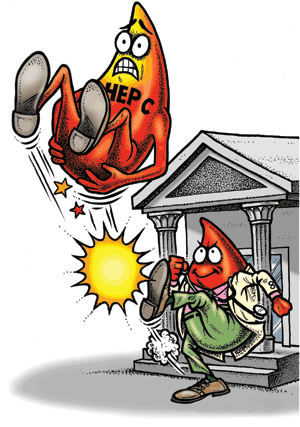 |
|||||||||
|
March/April 2016
Investigators from the Centers for Disease Control (directed by Daniel W. Bradley) and Chiron (Michael Houghton) identified HCV in 1989. In 1990, blood banks began screening blood donors for the virus, but it wasn’t until 1992 that a blood test was perfected that effectively eliminated HCV from the blood transfusion supply. Today less than one per two million transfused units of blood is estimated to be tainted with HCV. Prior to the screening of the blood supply for HCV, most Americans contracted it through blood transfusions or blood products and many of these were Vietnam veterans. In November 1997 a VA researcher published the first large-scale study of HCV infection among patients in VA hospitals. In just a three-year period, the number of HCV-infected patients rose more than 285 percent—from 6,612 in 1991 to 18,854 in 1994. An article in the April/May 1998 issue of The VVA Veteran by Bill Triplett included excerpts of a letter from former U.S. Surgeon General C. Everett Koop to VVA National President George Duggins in which Dr. Koop noted, “Veterans are one of the groups with the highest infection rates. [VA studies] indicate that as many as one in five vets [in VA hospitals] may be infected with HCV.” In a letter to the deputy director of the CDC, Dr. Koop also stated that “we have done little or nothing to educate at-risk populations.” What’s more, at that time, treatments using the drug interferon alpha or a mixture of interferon and ribavirin were not encouraging. For many infected veterans, the side effects of these treatments only caused more problems. Although Triplett’s article raised the HCV issue to a higher level at VVA, it was the 1998 VVA National Leadership Conference that hit home for VVA leaders and members. Health Policy Analysts, a Washington-based consulting firm, arranged for free blood testing at the conference through a donation from the drug manufacturer Schering-Plough. In the Dec 1998/Jan 1999 issue of The VVA Veteran, Audrey Spolarich and Bill Russo wrote that 166 veterans took the test at the conference and 19 tested either positive or inconclusive for HCV, including George Duggins. After all re-testing was complete, 14 veterans were found to have HCV—an infection rate of 8.4 percent, as compared with a 1.8 percent infection rate in the general population. According to Spolarich and Russo, after the Leadership Conference “VVA began meeting with members of Congress and their staffs, pressing the need for hepatitis C legislation,” including the question of whether veterans would be entitled to the presumption that they were infected during their military service. In early October 1998 VVA’s advocacy paid off when Sen. Olympia Snow (R-Maine) and Rep. Lane Evans (D-Ill.) championed S.2599 and H.R.4751. These companion bills were not acted upon but were re-introduced in the 1999 session and became law. In addition, on November 30, 1998, the director of VA’s Compensation and Pension Service issued a memorandum to all VA regional offices providing instructions on how to deal with veterans’ HCV claims.
Fast forward to the present: As Gary noted in her article, “the VA has now adopted a sweeping policy of offering and recommending hep C tests to all Vietnam-era veterans and all Baby Boomers (those born 1946-64)” and “the testing is now more accurate.” In fact, over the last few years, scientific advances have made treatment for HCV shorter, more effective, and injection-free. With the introduction of several new oral drugs that do not use interferon, the main goal of HCV treatment now is to be cured. This is defined as having no virus detected in the blood three months after treatment is completed (also known as achieving “sustained virologic response”). However, oral treatment options for HCV and length of treatment can vary widely depending on which medicines are used, the degree of liver damage, and the patient’s genotype. Since early 2015 the VA has begun using these oral treatments in its HVC program. However, the stigma of how HCV was acquired remains, and there are two new problems: the high cost of the new curative drugs and the Veterans Choice Program. The VA claims that it was not prepared financially to start wholesale treatment for all affected veterans. This led the VA to develop a protocol setting out how veterans would receive the new treatments. So in the fall of 2015 VVA successfully lobbied for $1.5 billion in each of the next two fiscal years (FY2016 and FY2017) for the VA’s HCV treatment program—$810 million more than the President had recommended. However, according to VA Secretary McDonald’s congressional testimony on February 11, “VA clinicians have rapidly adopted new, more effective therapies for HCV as they have become available. New therapies are costly and require well-trained clinical providers and support staff, presenting resource challenges for the Department. “VA will focus resources on the sickest patients and most complex cases and continue to build capacity for treatment through clinician training and use of telehealth platforms. Patients with less advanced disease are being offered treatment through the Veterans Choice Program in partnership with community HCV providers.” The policy of prioritizing infected veterans abruptly ended on February 24. The VA’s Assistant Deputy Under Secretary for Health for Clinical Operations and Acting Assistant Deputy Under Secretary for Health and Patient Care Services issued a joint memo to VA facility management and chiefs of pharmacy that announced: “Effective immediately for the rest of FY 2016, all veterans with HCV may receive treatment within VA facilities without regard to stage of liver disease; the use of prioritization protocol to determine eligibility for treatment within VA is no longer in effect…. Even though we are not limiting treatments, facilities should manage resources to ensure that patients with more advanced disease receive treatment as soon as possible and continue outreach to such patients to offer them treatment. “Veterans who have been offered HCV treatment through Choice, but have not yet seen a Choice HCV provider may elect, at the veteran’s discretion, to receive treatment at a VA facility or continue the referral to a Choice HCV provider.” Early detection and the new curative treatments prevent liver cancer and are more cost effective than liver transplants. Most importantly, they will save veterans’ lives.
|
|||||||||
|
|
|||||||||
Endowing the Future |
|||||||||
8719 Colesville Road, Suite 100, Silver Spring. MD 20910 | www.vva.org | contact us |
|||||||||





















 BY TOM BERGER
BY TOM BERGER  Scientists developed blood tests to identify hepatitis B in 1963 and hepatitis A in 1973, but many of the blood samples taken for post-transfusion illness (as it was called then) tested negative for hepatitis A and hepatitis B. Given that the primary mode of transmission (blood transfusion) was the same, scientists classified the unidentified cases as non-A, non-B hepatitis. We now believe that approximately 90-95 percent of cases previously classified as non-A, non-B were actually the hepatitis C virus (HCV) one of the leading causes of cirrhosis of the liver and liver cancer.
Scientists developed blood tests to identify hepatitis B in 1963 and hepatitis A in 1973, but many of the blood samples taken for post-transfusion illness (as it was called then) tested negative for hepatitis A and hepatitis B. Given that the primary mode of transmission (blood transfusion) was the same, scientists classified the unidentified cases as non-A, non-B hepatitis. We now believe that approximately 90-95 percent of cases previously classified as non-A, non-B were actually the hepatitis C virus (HCV) one of the leading causes of cirrhosis of the liver and liver cancer.